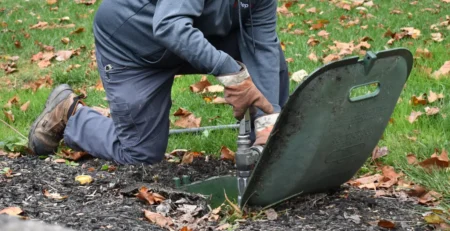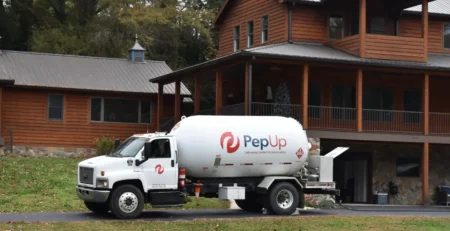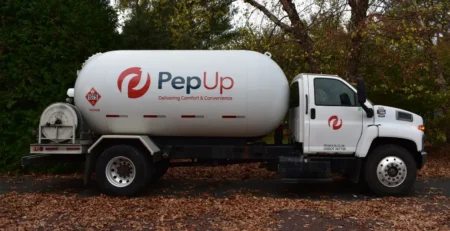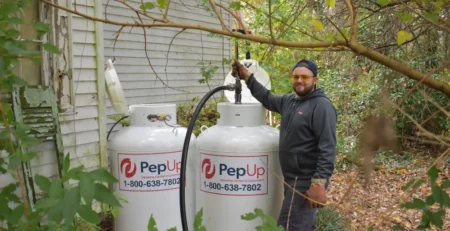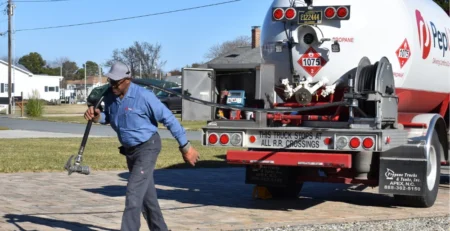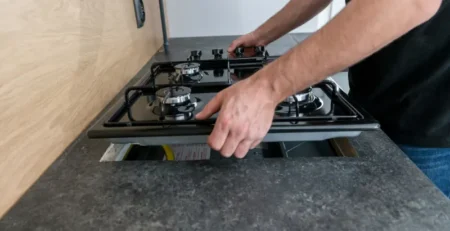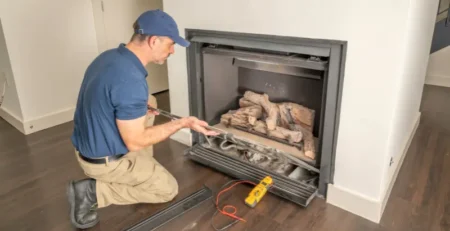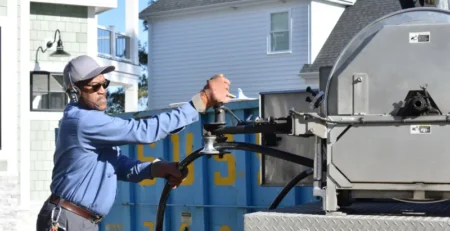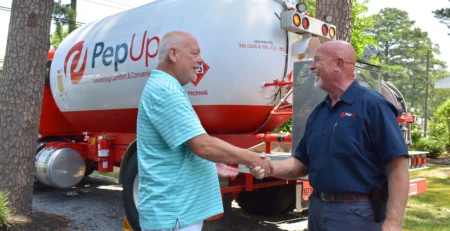Our team’s top picks for ways to heat patio spaces
You work hard to create inviting outdoor spaces at your home, so don’t miss out on using them when it’s cold outside! A propane patio heater can provide warmth and extend the usability of your patio no matter what the weather may bring.
Let’s look at some of the PepUp team’s recommended patio heating solutions and compare cost, ease of use, safety, and efficiency. Of course, we’ll be looking at clean-burning and reliable propane patio heaters, because that’s what our team knows best.
Heat your patio in a way that works for you
We’ll get into different ways to heat patio spaces and their pros and cons, but first we’d like to acknowledge that the ways people use their outdoor spaces are as varied as the people who use them. You may have (or be) that neighbor who wants to grill all year and invite everyone to share a meal on the patio. You may enjoy quiet evenings or mornings outdoors, and just need a little supplemental heat to take the edge off the winter chill. Or, you might want a roaring flame that provides ambience and warmth.
Propane can provide all those options. Let’s start with some basic considerations.
How much heat do you need?
Heating power is measured in British Thermal Units (BTUs), and generally the higher the number, the more heat output a solution offers.
- 10,000-25,000 BTUs can warm a small group of friends or family
- 25,000-40,000 BTUs will keep an outdoor dining area toasty (if covered)
- 40,000+ BTUs can heat a large outdoor tent, in case you’re planning a winter wedding reception
What fits your space and style?
Propane patio heaters come in just about every size, style, and configuration you can imagine. You can choose a tabletop heater that is compact and perfect for small spaces, and provide an intimate and warm conversation space. Or, replace the table with a fire pit that’s either movable or built-in. You can move the heat where you need it with freestanding pyramid or torch heaters, choose a tower heater that’s more powerful and keeps the heat low to the ground, or opt for a ceiling- or wall-mounted version that radiates heat in specific locations.
Consider your patio layout and whether it will change, or your style will change, when you’re thinking about ways to heat your patio this winter. Also, consider how easy it is to operate a heater with features like electronic ignition buttons, adjustable heat or flame settings, and wheels or light weight for mobility (while still being stable).
Patio heater models to consider
We’ve curated a variety of options that range in size, portability, and price. Generally, they all have good user reviews, but always read them for yourself! Quality with heaters isn’t guaranteed; there are a lot of manufacturers out there making heaters that are similar to trustworthy brands.
For tabletop use: AZ Patio Heaters HLDS01 Portable Tabletop Patio Heater
- Price: $100 – 150
- BTUs: 11,000
- Propane Supply: Uses 1 lb. propane cylinders (longer-lasting optional hose for 20 lb. tank)
This tabletop heater is among the largest of its kind, measuring 38 inches high. We like that it has a weight plate added to the bottom to prevent tipping it over, but it still has to be placed on a stable surface and out of traffic for the safest operation.
Things to consider:
- You can move it easily: Even with the weight plate, it’s 19 pounds without the propane cylinder. The base is 17 inches across, so consider your table size when looking at this model.
- Adjust the heat setting with a dial: This tabletop heater has a pretty good heating radius of 3 feet, with easy-to-use variable temperature control, and easy initial operation.
- Safety feature: The unit will automatically shut off if tilted to 45 degrees, which is an important failsafe for a smaller heater that could be knocked over. However, even after it’s turned off it will still be extremely hot and could burn someone or ignite combustible materials. Consider that when you’re arranging your space.
For uncovered spaces: Fire Sense Commercial Patio Heater
- Price: Approximately $150 – 200
- BTUs: 46,000
- Propane Supply: Uses standard 20 lb. propane tanks
This is a larger, commercial version of the patio heater you see at just about every outdoor restaurant. It features durable stainless steel construction, wheels for portability, and an easy-to-use ignition system. The weighted base hides the propane tank, and this heater can run up to 10 hours on 20 pounds of propane.
Things to consider:
- Cost to operate: The 46,000 BTU version provides a lot of heat and burns a lot of propane.
- Multiple purchase options: This heater style has been around for many years, so there are smaller versions at a variety of price points – and quality.
- Height: This particular unit is over 7 feet tall and requires about 30 inches of clearance above the top of the deflector, so it’s not well suited for most covered patios.
Small stand-alone fire feature: Bond Manufacturing Propane Firebowl Column
- Price: $350 – 450, depending on finishes and options
- BTUs: 40,000
- Propane Supply: Uses standard 20 lb. propane tanks
If you’re looking for a stand-alone patio heat source that creates its own ambience, feature, and conversation area, this propane fire bowl column fits the bill. It’s a hearty heat source and runs on a 20-lb. tank that fits inside the base, so you won’t have to worry about anyone tripping over gas lines. It’s tall enough that it won’t be mistaken for a table or seat when it isn’t lit, and the natural flames are a nice aesthetic.
Things to consider:
- This heater has design in mind: This is a higher-end investment because it’s made to fit in with a more traditional decor style that’s “outdoor rustic.” You’ll notice that the BTUs are about the same as the tower heater, so the heat for your patio will be the same, at about twice the initial purchase price.
- Rearranger-friendly: This unit has a small footprint and features lightweight faux stone. Wheels would help with moving, but at about 63 pounds it’s still fairly maneuverable without being easily tipped over.
Wall/ceiling mounted patio heating: Bromic Heating Tungsten SMART-HEAT Gas Series
- Price: High-end, priced around $1200 – $1600 without options like a heat deflector
- BTUs: 26,000
- Propane Supply: Requires a gas line from your home propane tank
The Bromic ceramic design gets fairly high-tech, and is for someone who is serious about how they heat patio spaces. For the BTUs, the 300 Model (whose specs we used here) is quite the investment. It’s the highest priced patio heater we’ve included, because we want you to know there are options out there for every budget and aesthetic.
Aside from the purchase price, the Bromic model has features that require add-on purchases, and it requires permanent, professional installation and gas line connection to your home propane tank.
Things to consider:
- Premium price, premium design: This brand is known for its quality, efficiency, and high-end service (and pricing).
- Options add flexibility and functionality: The wall mount that this model comes with requires 8 feet of ground clearance and 3 feet of ceiling clearance, requiring an optional deflector when mounted below a flat ceiling. You can also add easier-to-use On/Off controls, a pole mounting kit, and a smart home connection.
- High-end functions: Because of its design, this model features wind resistance like no other option we’ve explored. Its ceramic burners are also ultra efficient, and it offers pivoting capability for more control over where the heat goes.
Connecting a patio heater or custom fireplace, fire pit to your home propane supply tank
Connecting outdoor patio heaters to a large home propane supply tank can offer extended, uninterrupted use while eliminating the need for frequent tank changes. To do this safely, it’s essential to use a professionally installed high-capacity regulator and appropriate hoses that meet local codes and manufacturer specifications.
Give PepUp’s Energy Specialists a call to talk about your idea. Whether you want to connect a store-bought heater or fire feature to your propane tank, or you’ve decided to have one custom built, a certified technician should handle the installation to ensure proper connections and prevent leaks. Talk to our team early in your decision-making process so we can answer your questions about connections, compatibility, tank size, and safety before you buy. Let’s make your patio or outdoor kitchen the best place to hang out this fall and winter!
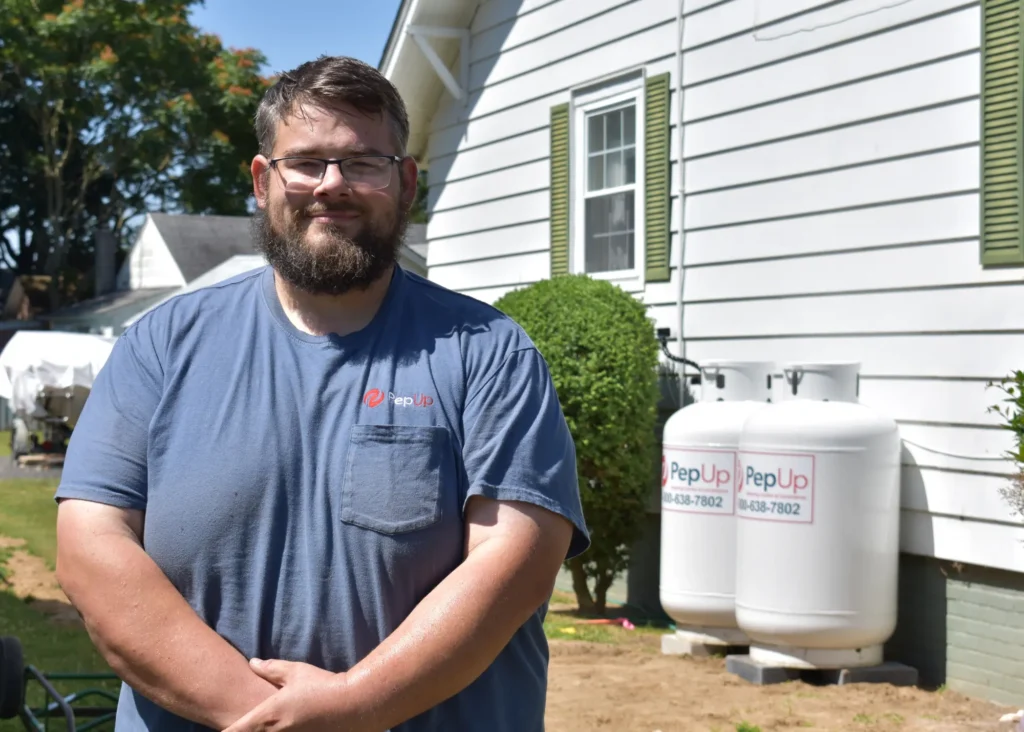
Meet PepUp Contributor and Delivery Driver, Kevin Gowe
Kevin started with PepUp in 2023. He and his wife, Hannah, are parents to 3 kids, one of whom was just born in July of 2024! His father in law is Keene Callahan, who was also with us for many years and recently retired. Kevin got his CDL shortly before joining our team, and previously worked in painting with his father.


